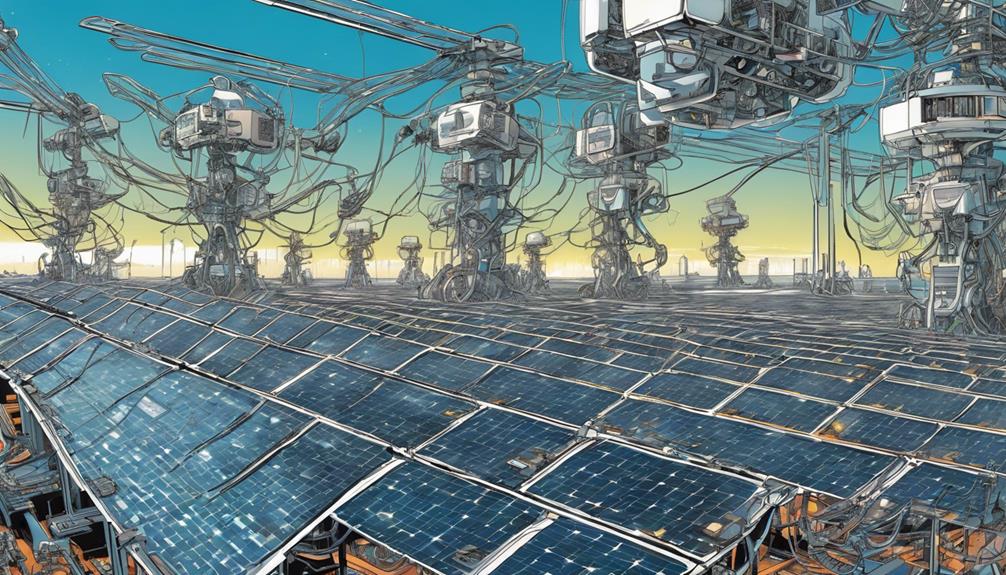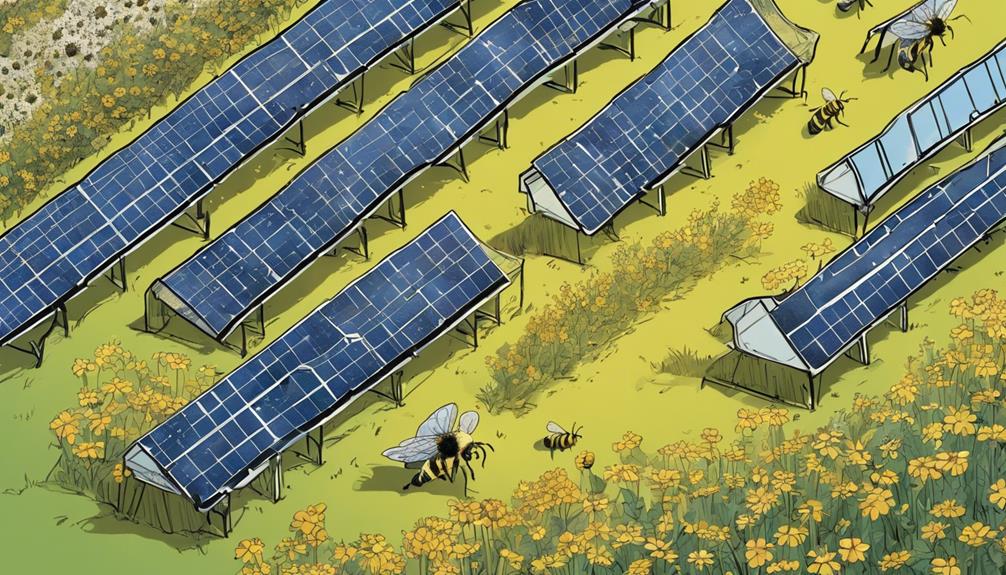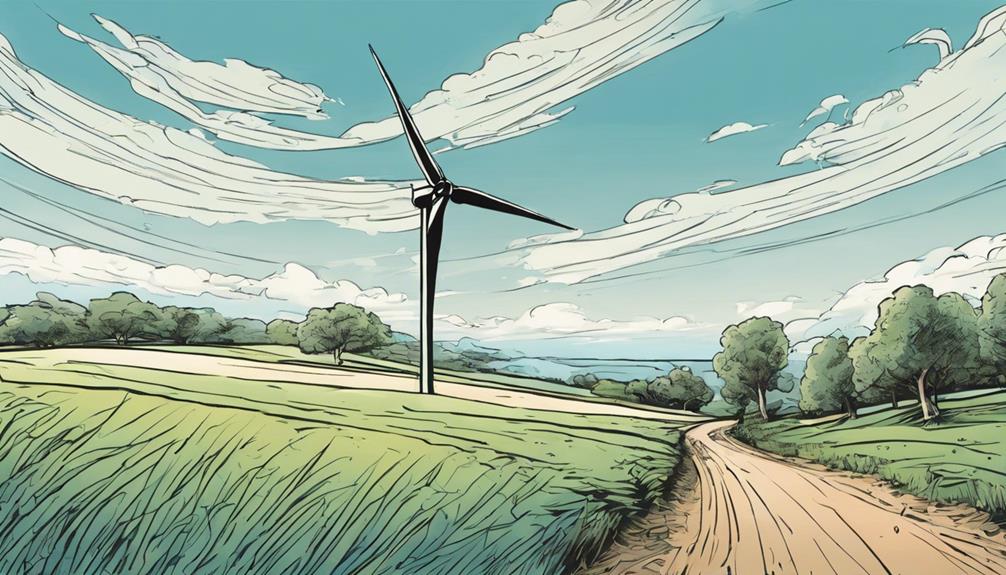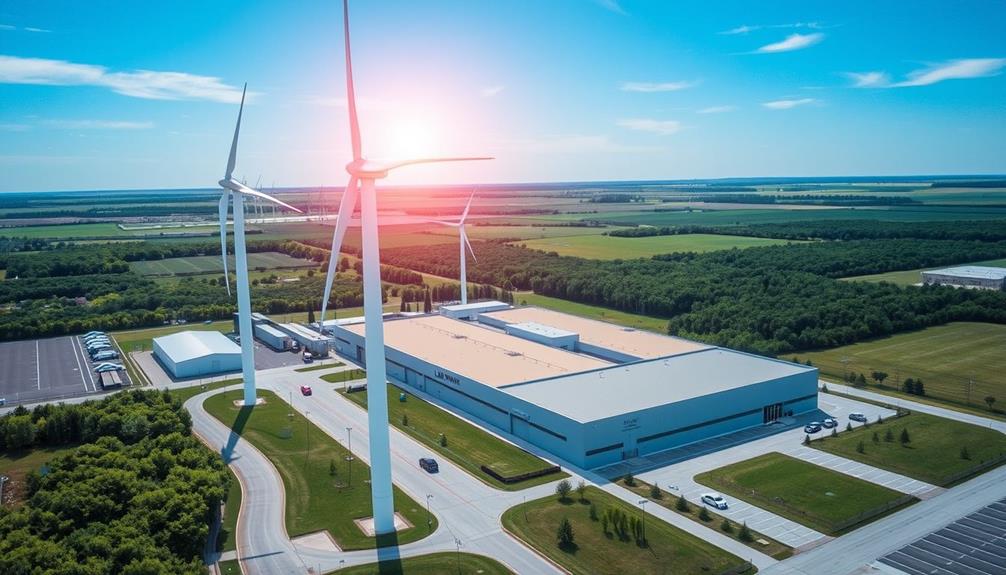I'm revolutionizing solar farm repairs with cutting-edge techniques. By shifting towards data-driven and technology-enabled maintenance approaches, I'm able to anticipate potential issues and minimize downtime. Advanced diagnostic tools like thermal imaging cameras and specialized software for asset management help me pinpoint problems efficiently. I'm also optimizing energy generation capacity through strategic panel placement and choosing high-efficiency panels. By embracing these innovative strategies, I'm maximizing energy output and profitability. Want to know more about how I'm staying ahead of the curve?
Key Takeaways
- Advanced maintenance strategies, like vibration analysis and condition-based monitoring, enable predictive repairs and minimize downtime in solar farms.
- Efficient repair techniques, including thermal imaging cameras and automation systems, reduce labor costs and increase energy output.
- Specialized diagnostic tools, such as multimeters and solar panel lifters, improve repair accuracy and efficiency in solar farms.
- Understanding panel degradation factors, like weather conditions and physical damage, helps optimize energy generation capacity and reduce output losses.
- Strategic panel placement, considering sunlight duration and shading factors, enhances energy capture and guarantees energy independence in solar farms.
Advanced Maintenance Strategies

Advanced maintenance strategies involve implementing proactive approaches to equipment upkeep to maximize efficiency and minimize downtime. These strategies focus on predictive maintenance techniques such as vibration analysis, infrared thermography, and oil analysis. By continuously monitoring key indicators, maintenance teams can anticipate potential issues before they occur, allowing for timely repairs or replacements. Additionally, advanced strategies may incorporate condition-based monitoring systems that use sensors to track equipment performance in real-time. This data enables the identification of patterns or anomalies that signal the need for maintenance interventions, helping to prevent costly breakdowns and extend the lifespan of assets.
Implementing advanced maintenance strategies requires a shift towards a more data-driven and technology-enabled maintenance approach. Companies may invest in specialized software for asset management and predictive analytics to streamline maintenance processes and optimize resource allocation. Furthermore, training programs may be necessary to equip maintenance personnel with the skills and knowledge needed to effectively utilize these advanced tools and techniques. By embracing these innovative strategies, organizations can enhance their operational reliability, reduce maintenance costs, and ultimately improve overall productivity and competitiveness in the market.
Implementing advanced maintenance strategies can often lead to a cultural shift within an organization, as it requires a proactive mindset towards equipment maintenance rather than a reactive one. By fostering a culture of continuous improvement and emphasizing the importance of preventive measures, companies can create a more sustainable and efficient maintenance environment. Collaboration between maintenance, operations, and management teams is crucial for the successful implementation of these strategies, as it requires a collective effort to prioritize maintenance activities, allocate resources effectively, and drive organizational change towards a more proactive maintenance approach.
Efficient Repair Techniques Unveiled

As I explore the realm of solar farm repairs, I've come to realize that effective repair techniques are essential in minimizing downtime and maximizing energy production.
One significant aspect is utilizing advanced tools like thermal imaging cameras to diagnose issues efficiently. These cameras detect hot spots or anomalies, allowing technicians to pinpoint problems quickly.
Additionally, innovations like automation systems and drones have streamlined the repair process, reducing labor costs and increasing precision.
By leveraging these cutting-edge techniques, solar farm owners can ensure swift and effective repairs, ultimately resulting in increased energy output and reduced maintenance costs.
Diagnostic Tools and Equipment

I'm now exploring the array of diagnostic tools and equipment that enable technicians to pinpoint issues efficiently, and it's clear that having the right gear is essential for a step-by-step assessment and diagnosis of solar farm problems.
A multimeter, for instance, allows us to measure voltage and current output, while thermal imaging cameras detect hot spots or anomalies. Specialized equipment like solar panel lifters and safety harnesses are also essential for safe and effective repairs.
High-quality tools improve efficiency and accuracy, and proper training for technicians is pivotal for effective tool usage. With the right tools, we can tackle complex issues with confidence, ensuring that solar farms operate at peak performance.
Understanding Panel Degradation Factors

As I explore the world of solar farm repairs, I've come to realize that understanding panel degradation factors is essential for best performance. Approximately 2% of a solar panel's energy output is lost annually due to degradation, a cumulative effect of various environmental and physical factors that can significantly impact overall farm efficiency.
| Factor | Description | Impact |
|---|---|---|
| Weather Conditions | Temperature, humidity, and UV exposure | Reduces energy output by 0.5-1% annually |
| Pollutants | Dust, dirt, and other airborne particles | Decreases energy output by 1-2% annually |
| Physical Damage | Cracks, scratches, and broken glass | Can reduce energy output by up to 5% annually |
Optimizing Energy Generation Capacity

By understanding the degradation factors that affect solar panel performance, I can now focus on enhancing energy generation capacity through strategic panel placement, efficient maintenance, and technology upgrades.
I analyze sunlight duration, weather data, and shading factors to determine the ideal panel placement. Choosing panels with high efficiency ratings guarantees maximum energy capture. Balancing upfront investment with long-term savings is vital for peak performance.
I also consider seasonal variations, energy usage patterns, and panel efficiency to determine the right number of panels. By evaluating these factors, I can guarantee energy independence and efficiency.
Effective Troubleshooting Methods

To quickly identify and resolve issues, effective troubleshooting methods are crucial. This involves a systematic approach that combines visual inspections, advanced diagnostic tools, and a thorough understanding of solar panel behavior.
As I assess a solar farm, I start with a visual inspection to identify physical damage or wear on panels. Next, I use a multimeter to measure voltage and current output, confirming it aligns with the expected values.
Thermal imaging cameras help detect hot spots or anomalies, while a systematic approach guides my troubleshooting and repairs. By following this methodical process, I can efficiently diagnose and address issues, minimizing downtime and maximizing energy generation.
This approach ensures that solar farms operate at peak levels, reducing costs and environmental impact.
Maximizing Panel Lifespan and Efficiency

Regular cleaning and maintenance are crucial to extend the lifespan of solar panels and enhance their performance, as even a thin layer of dirt or debris can significantly decrease energy output.
I've found that using advanced tools such as thermal imaging cameras helps diagnose issues effectively. Innovations like automation systems and drones have also enhanced repair efficiency.
To maximize panel performance, I employ techniques like regular cleaning with gentle solutions and debris removal. Additionally, I recommend applying protective coatings and monitoring systems to prevent panel degradation due to weather conditions and pollutants.
Frequently Asked Questions
What Are the Most Common Causes of Solar Panel Failure?
When I inspect solar panels, I often find that weather conditions and pollutants are the most common causes of failure, leading to panel degradation and reduced energy output.
Can Solar Panels Be Repaired or Must They Be Replaced?
"I've seen cases where solar panels can be repaired, but it depends on the type and extent of damage. If it's a minor issue, like loose connections or debris buildup, a simple fix might Suffice."
How Often Should Solar Panels Be Inspected for Maintenance?
I've found that regular inspections are essential; I recommend inspecting solar panels every 6 months to maintain peak performance and prevent potential issues, as neglecting maintenance can lead to decreased energy output and even panel damage.
What Are the Benefits of Using Drones in Solar Farm Repairs?
'I've found that using drones in solar farm repairs greatly reduces inspection time and cost, while increasing accuracy. They help detect issues like hotspots and defects, allowing for swift repairs and maximizing energy output.'
Can Solar Panels Be Repaired During Extreme Weather Conditions?
I recall a case where our team repaired a solar farm in a hurricane-ravaged area, using specialized equipment and protective gear. Generally, yes, solar panels can be repaired during extreme weather conditions, but it's important to prioritize technician safety and take necessary precautions.
How Can Cutting-Edge Techniques in Solar Farm Repairs Aid in Optimizing Energy Efficiency During Construction?
Cutting-edge techniques in solar farm repairs can optimize solar farm construction by ensuring that any damages or inefficiencies are quickly and effectively addressed. By leveraging advanced repair methods, such as drone technology or predictive maintenance, the energy efficiency of the solar farm can be maximized during the construction phase.
Conclusion
As I reflect on the innovations transforming solar farm repairs, I'm reminded that 'an ounce of prevention is worth a pound of cure.' By embracing cutting-edge techniques and technologies, we can minimize downtime, maximize energy output, and pave the way for a sustainable future.
The future of solar energy is bright, and I'm excited to be at the forefront of this revolution, driving progress and shaping a cleaner, greener tomorrow.









